Abstract
Previous results with the Babesia divergens gerbil vaccination model were extended in studies with cattle. Two calves were vaccinated with culture-derived B. divergens exoantigens, and two others were treated with control supernatant; both preparations were adjuvanted with Quil-A saponin. A parasite-specific humoral response was observed after the first vaccine injection and was boosted by two succeeding vaccine injections. Sera from the two vaccinated calves immunoprecipitated eight major parasitic proteins (with molecular masses ranging between 17 and 110 kDa) whose patterns were close to those observed in gerbil vaccine assays. The cellular immune response, monitored by lymphoproliferation assays, was slightly delayed in comparison with the humoral response; a significant proliferation occurred only after the second vaccine injection. Mononuclear cell proliferation was dose dependent in the presence of (i) lysates of B. divergens-parasitized erythrocytes, (ii) exoantigens of the whole supernatant, or (iii) protective exoantigens of two low-molecular-mass fractions obtained after supernatant gel filtration chromatography. An infectious challenge was administered 3 weeks after the third vaccine injection, with 3.6 x 10(10) B. divergens-parasitized erythrocytes. Erythrocyte count, rectal temperature, and parasitemia of the animals were monitored daily until they returned to initial values. All parameters indicated that the exoantigens induced protection from B. divergens infection for the two vaccinated calves.
Full text
PDF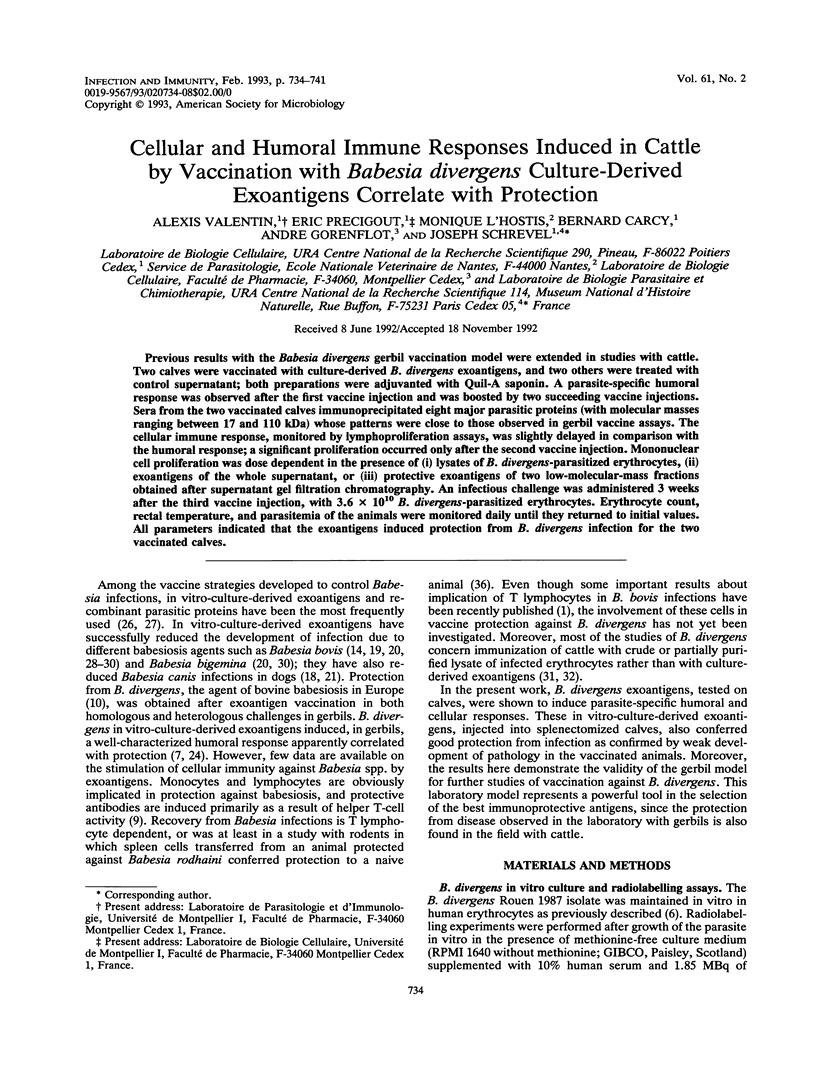
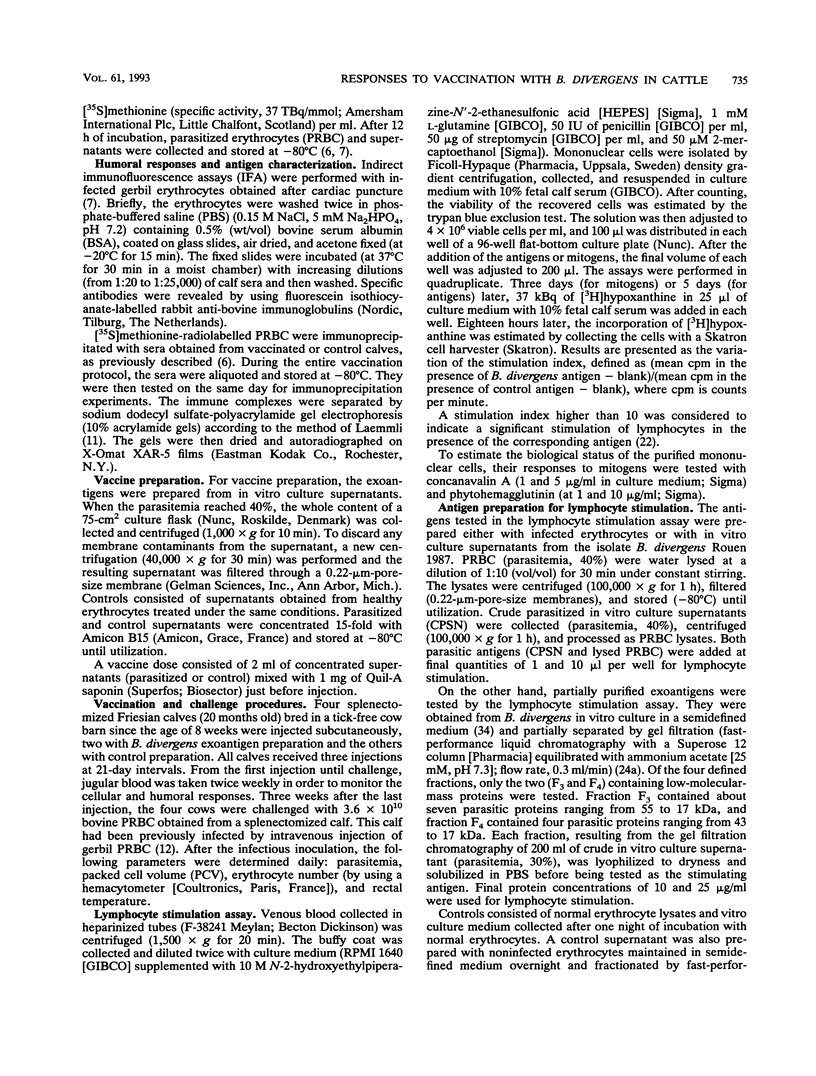
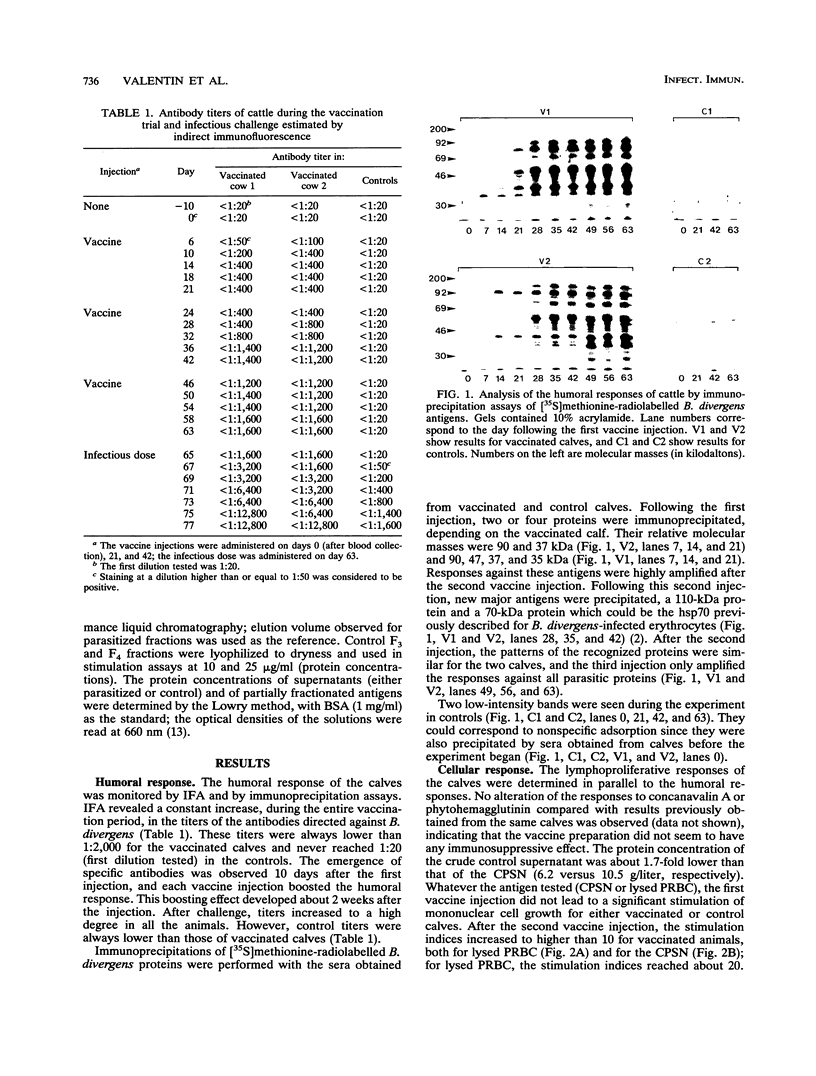
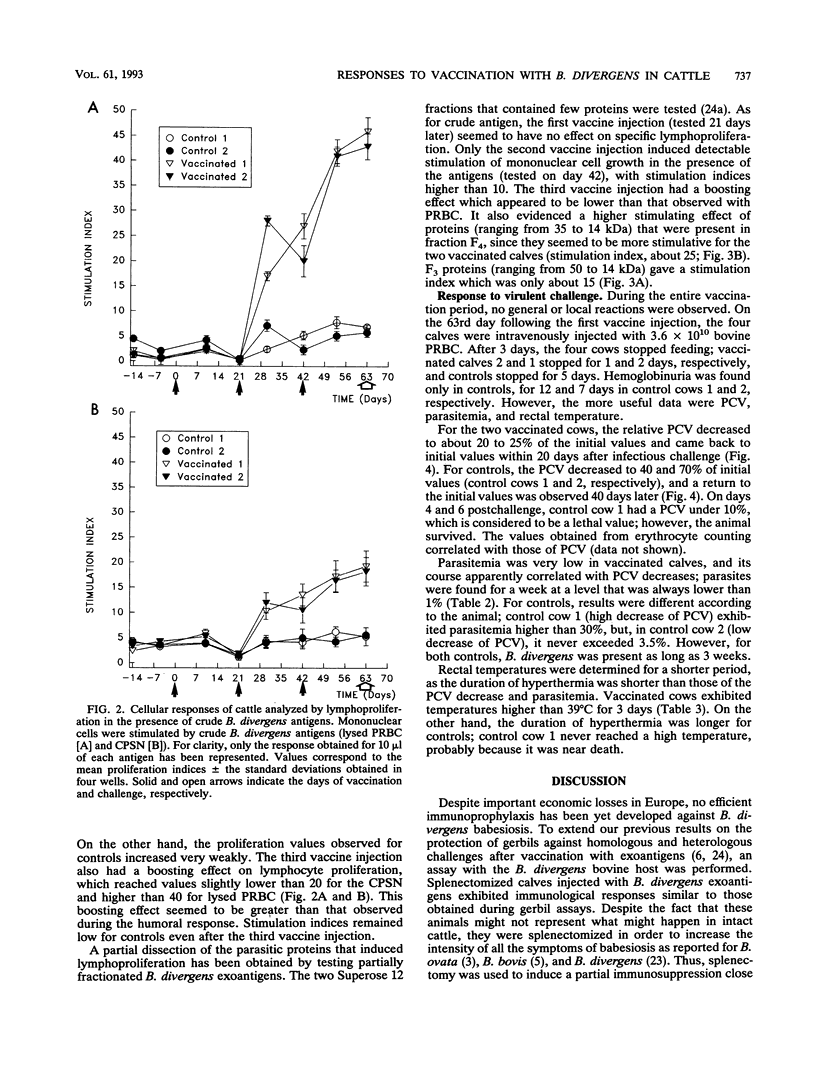
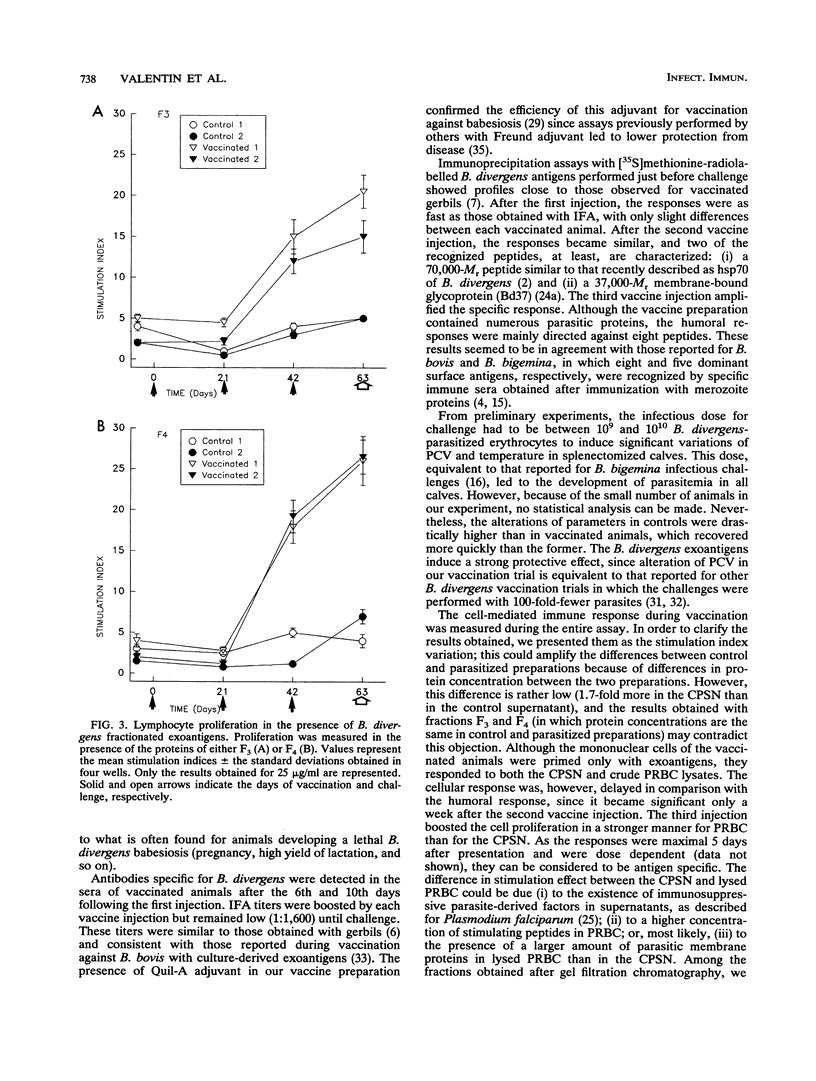
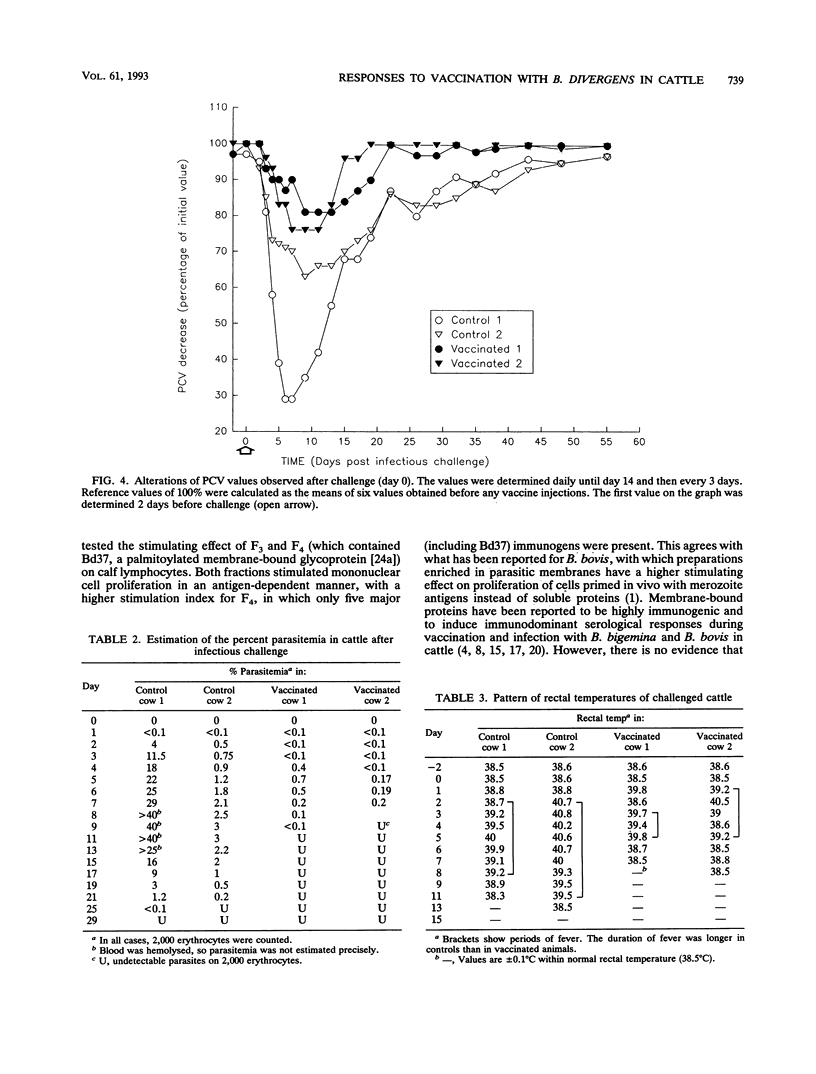
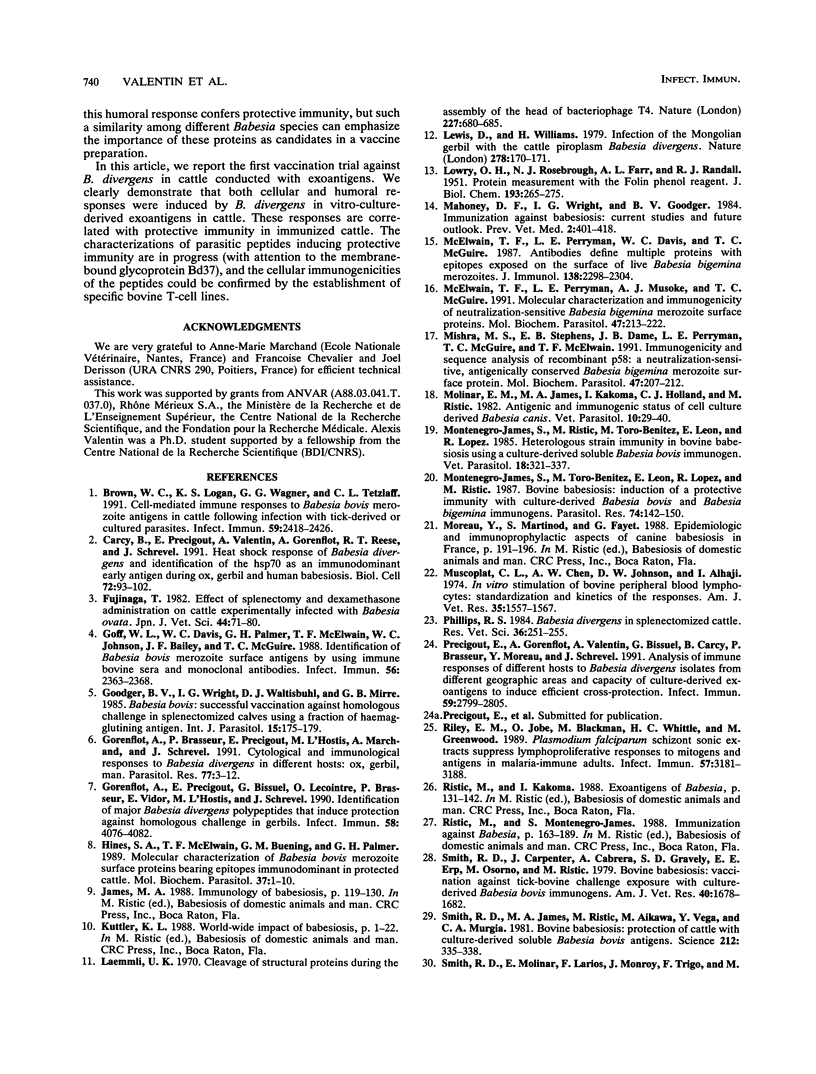
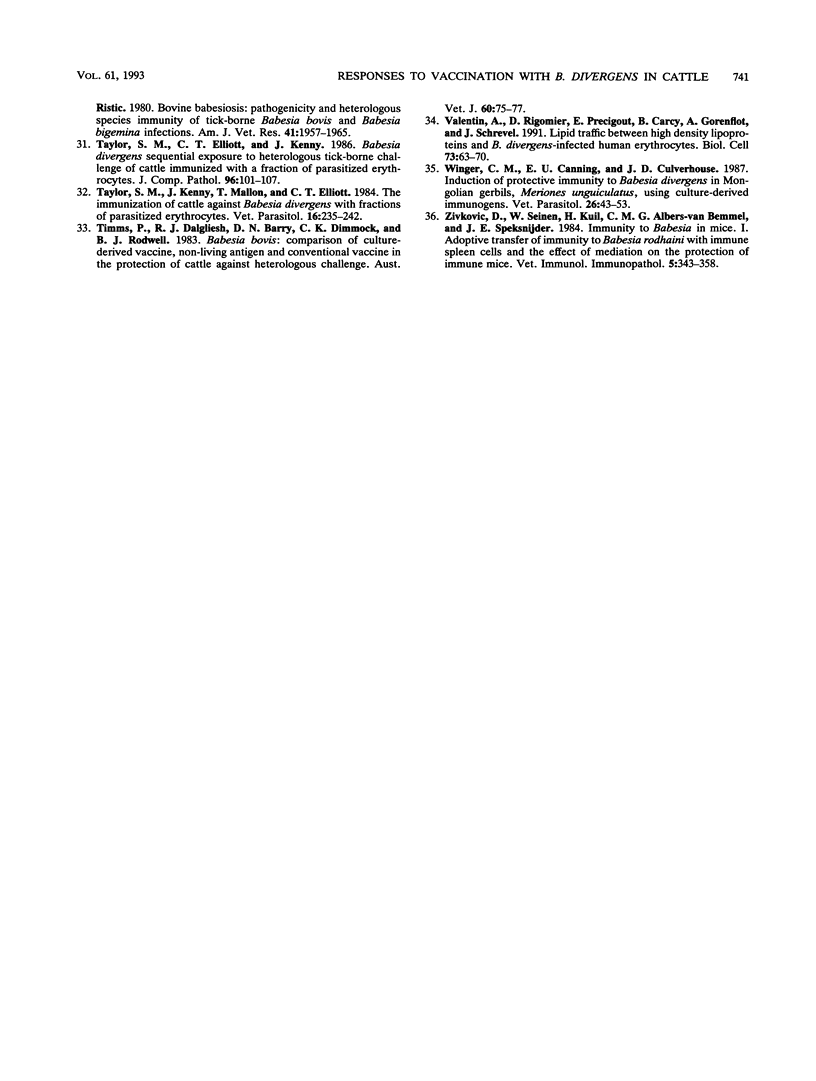
Images in this article
Selected References
These references are in PubMed. This may not be the complete list of references from this article.
- Brown W. C., Logan K. S., Wagner G. G., Tetzlaff C. L. Cell-mediated immune responses to Babesia bovis merozoite antigens in cattle following infection with tick-derived or cultured parasites. Infect Immun. 1991 Jul;59(7):2418–2426. doi: 10.1128/iai.59.7.2418-2426.1991. [DOI] [PMC free article] [PubMed] [Google Scholar]
- Carcy B., Précigout E., Valentin A., Gorenflot A., Reese R. T., Schrével J. Heat shock response of Babesia divergens and identification of the hsp70 as an immunodominant early antigen during ox, gerbil and human babesiosis. Biol Cell. 1991;72(1-2):93–102. doi: 10.1016/0248-4900(91)90083-y. [DOI] [PubMed] [Google Scholar]
- Fujinaga T. Effect of splenectomy and dexamethasone administration on cattle experimentally infected with Babesia ovata. Nihon Juigaku Zasshi. 1982 Feb;44(1):71–80. doi: 10.1292/jvms1939.44.71. [DOI] [PubMed] [Google Scholar]
- Goff W. L., Davis W. C., Palmer G. H., McElwain T. F., Johnson W. C., Bailey J. F., McGuire T. C. Identification of Babesia bovis merozoite surface antigens by using immune bovine sera and monoclonal antibodies. Infect Immun. 1988 Sep;56(9):2363–2368. doi: 10.1128/iai.56.9.2363-2368.1988. [DOI] [PMC free article] [PubMed] [Google Scholar]
- Goodger B. V., Wright I. G., Waltisbuhl D. J., Mirre G. B. Babesia bovis: successful vaccination against homologous challenge in splenectomised calves using a fraction of haemagglutinating antigen. Int J Parasitol. 1985 Apr;15(2):175–179. doi: 10.1016/0020-7519(85)90084-0. [DOI] [PubMed] [Google Scholar]
- Gorenflot A., Brasseur P., Precigout E., L'Hostis M., Marchand A., Schrevel J. Cytological and immunological responses to Babesia divergens in different hosts: ox, gerbil, man. Parasitol Res. 1991;77(1):3–12. doi: 10.1007/BF00934377. [DOI] [PubMed] [Google Scholar]
- Gorenflot A., Precigout E., Bissuel G., Lecointre O., Brasseur P., Vidor E., L'Hostis M., Schrevel J. Identification of major Babesia divergens polypeptides that induce protection against homologous challenge in gerbils. Infect Immun. 1990 Dec;58(12):4076–4082. doi: 10.1128/iai.58.12.4076-4082.1990. [DOI] [PMC free article] [PubMed] [Google Scholar]
- Hines S. A., McElwain T. F., Buening G. M., Palmer G. H. Molecular characterization of Babesia bovis merozoite surface proteins bearing epitopes immunodominant in protected cattle. Mol Biochem Parasitol. 1989 Nov;37(1):1–9. doi: 10.1016/0166-6851(89)90096-0. [DOI] [PubMed] [Google Scholar]
- LOWRY O. H., ROSEBROUGH N. J., FARR A. L., RANDALL R. J. Protein measurement with the Folin phenol reagent. J Biol Chem. 1951 Nov;193(1):265–275. [PubMed] [Google Scholar]
- Laemmli U. K. Cleavage of structural proteins during the assembly of the head of bacteriophage T4. Nature. 1970 Aug 15;227(5259):680–685. doi: 10.1038/227680a0. [DOI] [PubMed] [Google Scholar]
- Lewis D., Williams H. Infection of the Mongolian gerbil with the cattle piroplasm Babesia divergens. Nature. 1979 Mar 8;278(5700):170–171. doi: 10.1038/278170a0. [DOI] [PubMed] [Google Scholar]
- McElwain T. F., Perryman L. E., Davis W. C., McGuire T. C. Antibodies define multiple proteins with epitopes exposed on the surface of live Babesia bigemina merozoites. J Immunol. 1987 Apr 1;138(7):2298–2304. [PubMed] [Google Scholar]
- McElwain T. F., Perryman L. E., Musoke A. J., McGuire T. C. Molecular characterization and immunogenicity of neutralization-sensitive Babesia bigemina merozoite surface proteins. Mol Biochem Parasitol. 1991 Aug;47(2):213–222. doi: 10.1016/0166-6851(91)90181-5. [DOI] [PubMed] [Google Scholar]
- Mishra V. S., Stephens E. B., Dame J. B., Perryman L. E., McGuire T. C., McElwain T. F. Immunogenicity and sequence analysis of recombinant p58: a neutralization-sensitive, antigenically conserved Babesia bigemina merozoite surface protein. Mol Biochem Parasitol. 1991 Aug;47(2):207–212. doi: 10.1016/0166-6851(91)90180-e. [DOI] [PubMed] [Google Scholar]
- Molinar E., James M. A., Kakoma I., Holland C., Ristic M. Antigenic and immunogenic studies on cell culture-derived Babesia canis. Vet Parasitol. 1982 Mar;10(1):29–40. doi: 10.1016/0304-4017(82)90004-8. [DOI] [PubMed] [Google Scholar]
- Montenegro-James S., Ristic M., Toro Benitez M., Leon E., Lopez R. Heterologous strain immunity in bovine babesiosis using a culture-derived soluble Babesia bovis immunogen. Vet Parasitol. 1985 Dec;18(4):321–337. doi: 10.1016/0304-4017(85)90067-6. [DOI] [PubMed] [Google Scholar]
- Montenegro-James S., Toro Benitez M., Leon E., Lopez R., Ristic M. Bovine babesiosis: induction of protective immunity with culture-derived Babesia bovis and Babesia bigemina immunogens. Parasitol Res. 1987;74(2):142–150. doi: 10.1007/BF00536025. [DOI] [PubMed] [Google Scholar]
- Muscoplat C. C., Chen A. W., Johnson D. W., Alhaji I. In vitro stimulation of bovine peripheral blood lymphocytes: standardization and kinetics of the response. Am J Vet Res. 1974 Dec;35(12):1557–1561. [PubMed] [Google Scholar]
- Phillips R. S. Babesia divergens in splenectomised rats. Res Vet Sci. 1984 Mar;36(2):251–255. [PubMed] [Google Scholar]
- Precigout E., Gorenflot A., Valentin A., Bissuel G., Carcy B., Brasseur P., Moreau Y., Schrevel J. Analysis of immune responses of different hosts to Babesia divergens isolates from different geographic areas and capacity of culture-derived exoantigens to induce efficient cross-protection. Infect Immun. 1991 Aug;59(8):2799–2805. doi: 10.1128/iai.59.8.2799-2805.1991. [DOI] [PMC free article] [PubMed] [Google Scholar]
- Riley E. M., Jobe O., Blackman M., Whittle H. C., Greenwood B. M. Plasmodium falciparum schizont sonic extracts suppress lymphoproliferative responses to mitogens and antigens in malaria-immune adults. Infect Immun. 1989 Oct;57(10):3181–3188. doi: 10.1128/iai.57.10.3181-3188.1989. [DOI] [PMC free article] [PubMed] [Google Scholar]
- Smith R. D., Carpenter J., Cabrera A., Gravely S. M., Erp E. E., Osorno M., Ristic M. Bovine babesiosis: vaccination against tick-borne challenge exposure with culture-derived Babesia bovis immunogens. Am J Vet Res. 1979 Dec;40(12):1678–1682. [PubMed] [Google Scholar]
- Smith R. D., James M. A., Ristic M., Aikawa M., Vega y Murguia C. A. Bovine babesiosis: protection of cattle with culture-derived soluble Babesia bovis antigen. Science. 1981 Apr 17;212(4492):335–338. doi: 10.1126/science.7209532. [DOI] [PubMed] [Google Scholar]
- Smith R. D., Molinar E., Larios F., Monroy J., Trigo F., Ristic M. Bovine babesiosis: pathogenicity and heterologous species immunity of tick-borne Babesia bovis and B bigemina infections. Am J Vet Res. 1980 Dec;41(12):1957–1965. [PubMed] [Google Scholar]
- Taylor S. M., Elliott C. T., Kenny J. Babesia divergens: sequential exposure to heterologous tick-borne challenge of cattle immunized with a fraction of parasitized erythrocytes. J Comp Pathol. 1986 Jan;96(1):101–107. doi: 10.1016/0021-9975(86)90027-7. [DOI] [PubMed] [Google Scholar]
- Taylor S. M., Kenny J., Mallon T., Elliott C. T. The immunization of cattle against Babesia divergens with fractions of parasitized erythrocytes. Vet Parasitol. 1984 Nov;16(3-4):235–242. doi: 10.1016/0304-4017(84)90041-4. [DOI] [PubMed] [Google Scholar]
- Timms P., Dalgliesh R. J., Barry D. N., Dimmock C. K., Rodwell B. J. Babesia bovis: comparison of culture-derived parasites, non-living antigen and conventional vaccine in the protection of cattle against heterologous challenge. Aust Vet J. 1983 Mar;60(3):75–77. doi: 10.1111/j.1751-0813.1983.tb05874.x. [DOI] [PubMed] [Google Scholar]
- Valentin A., Rigomier D., Précigout E., Carcy B., Gorenflot A., Schrével J. Lipid trafficking between high density lipoproteins and Babesia divergens-infected human erythrocytes. Biol Cell. 1991;73(1):63–70. doi: 10.1016/0248-4900(91)90010-k. [DOI] [PubMed] [Google Scholar]
- Winger C. M., Canning E. U., Culverhouse J. D. Induction of protective immunity to Babesia divergens in Mongolian gerbils, Meriones unguiculatus, using culture-derived immunogens. Vet Parasitol. 1987 Dec;26(1-2):43–53. doi: 10.1016/0304-4017(87)90075-6. [DOI] [PubMed] [Google Scholar]
- Zivkovic D., Seinen W., Kuil H., Albers-van Bemmel C. M., Speksnijder J. E. Immunity to Babesia in mice. I. Adoptive transfer of immunity to Babesia rodhaini with immune spleen cells and the effect of irradiation on the protection of immune mice. Vet Immunol Immunopathol. 1984 Mar;5(4):343–357. doi: 10.1016/0165-2427(84)90003-5. [DOI] [PubMed] [Google Scholar]



